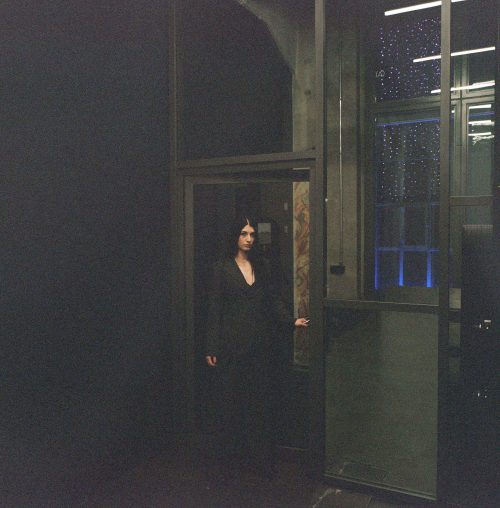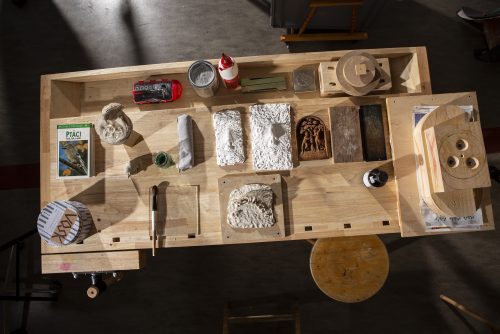
Emma Adler, Rebekka Benzenberg, Ferdinand Dölberg, Olga Hohmann, Dorian Sari, Avery Gia Sophie Schramm, Helena Uambembe, Nicholas Warburg
Look!
Project Info
- 💙 Galerie Anton Janizewski
- 🖤 Emma Adler, Rebekka Benzenberg, Ferdinand Dölberg, Olga Hohmann, Dorian Sari, Avery Gia Sophie Schramm, Helena Uambembe, Nicholas Warburg
- 💜 Philipp Hindahl
- 💛 Julian Blum
Share on

Advertisement



















The exhibition Look! assembles work by eight young artists in the new space of Galerie Anton Janizewski. Some of them deal with the complicated relation of art and labor, others reflect on what it means to live in a world of digital images. Other works deal with the traumas of history and the immediate urban space. What they all have in common is that they deal with contemporary issues in unique ways.
Avery Gia Sophie Schramm’s paintings seem to have been ripped out of a newsfeed and given a new materiality. Schramm paints four pandas, in poses, which suggest playful calm, against a monochrome purple background, a turning away from the world and from any productive labor. Schramm found the templates on Instagram, paradoxically a platform that is designed to maximize content production and capture attention.
The four pandas are the beginning of something new in Schramm’s work, as they previously adapted memes, which were then translated into oil on canvas. Memes already explode with meaning, and they re-contextualize the incoherent and give new sense to fragments of image and text after they have gone through countless reposts. Schramm then makes new combinations. The adaptations show an interest in the political content of the online images, but they never reproduce the cynicism that is often inherent in it. In the paintings, only the title is added as an additional element: DIALEKTIK DER AUFKLÄRUNG 1-4 (Titel Max Horkheimer and Theodor W. Adorno, Internet Pandas), a reference to critical theory, which is an important point of reference for Schramm. But the titles never provide a fixed reading, just as these pictures are also semantically as open as possible.
Nicholas Warburg’s painting comes from a series of pictures that appear like variations on Gerhard Richter's RAF cycle 18 October (1988). While Richter painted Meins, Baader, and Meinhof based on photos from a magazine, Warburg used stills from documentary films about Antifa or graphics from posters. The artist omits the heaviness of historical meaning in Richter's painting and replaces it with exemplary images of left-wing socialization and an autobiographical lightness. What remains is a historical continuity of the uncanny, which the historian Philipp Felsch once described as BRD Noir: the unresolved contradictions of German history, which were inscribed in the cultural production of post-war decades in Germany and at least until reunification, as well as the latent violence beneath the surface of the provinciality of those years. The artist, who lives in Frankfurt am Main, usually works with German history, repression and guilt, and his installations and pictures combine pop culture and nostalgia.
Emma Adler's practice focuses on how conspiracy theories and the visual worlds of politics intersect. For Look!, she examined an AfD sharepic that was so obviously generated using artificial intelligence that the question of its intention seems all the more puzzling. Adler isolates one element of the image: a hand, almost monstrous with its extra fingers, which she translates into a sculpture resting on a stone basket of the kind often found in German front gardens.
Such media changes are an important part of Adler's practice. Earlier installations have referenced the immersive worlds of video games, where the artist was interested in making real spaces appear like the rendered non-places of games by repeating textures, not on digital polygons, but on the wall in the exhibition space. Other works translate objects and images of our present into objects that are difficult to read—a public urinal looks like a sinister gothic tower—and she transforms the AI-generated hand of right-wing populists into a print that is reminiscent of early modern prints prevalent at the time of witch trials. In her expansive installations, Adler explores conspiracy ideologies on the far right, media representations and their complicated relationship to reality. These topics have taken on a particular urgency at least since 2020, the year in which the pandemic and right-wing populism have destabilized, if not undermined, shared political discourse. Adler's works are the physical expression of such research, but they are deeply rooted in the digital.
Rebekka Benzenberg transfers signs and signatures from everyday life into the gallery space, and for Look! she continues this strategy, with which she has already worked in various media. Her soot paintings are similar to the graffiti practice of leaving tags with a lighter, often on ceilings. Benzenberg engages in a kind of pictorial archaeology when she translates female nudes from the art-historical canon—paintings by Botticelli, for example, or Rubens—into such soot images, which she produces quickly and upside down. Benzenberg poses the question of the socially informed gaze: Why can't we look at ourselves without pre-constructed schemata, why is the passive pose always already presupposed for female-read bodies? The artist quotes such figures in her ghostly soot drawings, like revenants of art history. Adaptation is her strategy of choice anyway. In her past works, Benzenberg uses fashion and slogans—“Too Much Future", for example, a punk slogan in the GDR, which she etched onto fur coats sewn together. Her work is often based on a fascination with latent aggression that defies established social power structures.
Ferdinand Dölberg’s painting Working is the Beginning of all Evil is a continuation of his earlier figurative paintings, formally at least. But a heaviness creeps in. The pictorial space is closed off in the background, depth is only created by the staggered planes, figures look downwards or past the viewer out of the picture. The subject is an old, important theme in painting at least since the 19th century—we see people at work. But here, the activity is not heroic. Instead, the figures are working on an assembly line. This recalls the harshness of New Objectivity (Neue Sachlichkeit), were it not for something playful, such as a person lingering or procrastinating. The picture hints at two sides of a critique, on the one hand the fear of standardization through work, but on the other hand, the work is being done collectively. What at first glance appears to be a depiction of isolation is much more ambiguous: is one of the abstract figures in the background putting their arm protectively around another? Is there beauty in the mistakes that Dölberg's assembly line workers make, are they perhaps even an expression of creativity? Or must they also fall victim to standardizing alienation in the end?
The video work Look! by Dorian Sari, which gives the group exhibition its title, contradicts the expectations of a film. The protagonist points at something somewhere outside the image and repeatedly shouts "look, look" until spittle drips from his chin—frustratingly, the camera does not pan, despite his desperation. This is media criticism, but also a commentary on the limits of human perception. We can't look everywhere, no matter how much the protagonist pushes his own body to its limits. How is information selected, one begins to wonder. This applies formally to this video work, but also to the wider political space—which conflicts and whose suffering are shown in the media? Another work by the Basel-based artist is called Appreciate what you have, Immigrant, a small, black-framed sign hanging on an oversized nail with the text that gives it its title. This phrase, the artist says, is often heard, especially when artists and non-artists criticize the country they live in.
The two works that Helena Uambembe has contributed to Look! are an experiment of sorts. With two collages, the South African-born artist tried out drawing with charcoal over cyanotypes for the first time. They were created while Uambembe was preparing an exhibition at the Museum für Moderne Kunst in Frankfurt. The cyanotypes—a photographic process that has been in use since the 19th century—show the town of Pomfret in north-western South Africa, where the artist was born.
Uambembe’s work tells stories, and the exhibition at the MMK was about refugees from Angola who were forced to join the South African army in the 1970s in order to fight the independence movements in Namibia and Angola. After the end of the Cold War, the soldiers and their families were resettled in Pomfret, a place with an asbestos mine. Finally, in the early 2000s, the inhabitants were to be resettled again, but many refused, and the place remains a Portuguese-speaking enclave to this day. Uambembe creates installations and performances, and they resemble archives that preserve the past and work through trauma.
Olga Hohmann’s contribution focuses on Rosa Luxemburg and the herbarium the politician and author created during her time in prison. Hohmann does not limit herself to physical pieces in the gallery, and an important part in her work is music. In a performance with a cellist and a violinist, reminiscent of the bourgeois tradition of house music, workers’ songs are performed, among other things. The music is fleeting, but what remains in the gallery is a bouquet of all the flowers that Luxemburg has preserved in her herbarium. They gradually dry in an unfired vase - designed by Anna Maria Łuczak. Like most of Hohmann’s performances and exhibitions, these works are created in collaboration with other artists. Another part of the contribution is a letter from the imprisoned Luxemburg to Karl Liebknecht about her relation to the animal and plant world. Politics is not mentioned in this text, but is present. Hohmann has written a response to this letter, which deals with the conditions of artistic labor, and the immediate urban space at Rosa-Luxemburg-Platz.
— Philipp Hindahl
Philipp Hindahl




